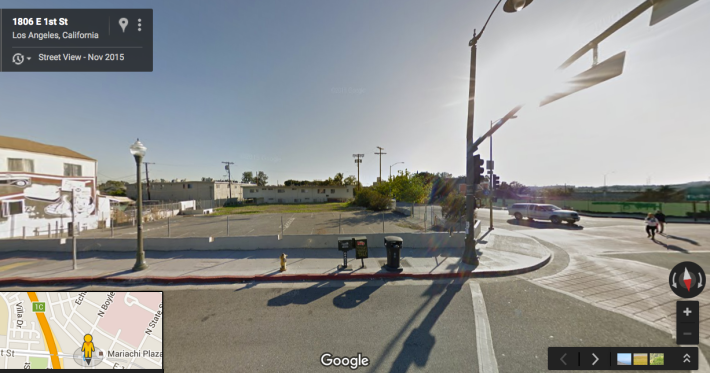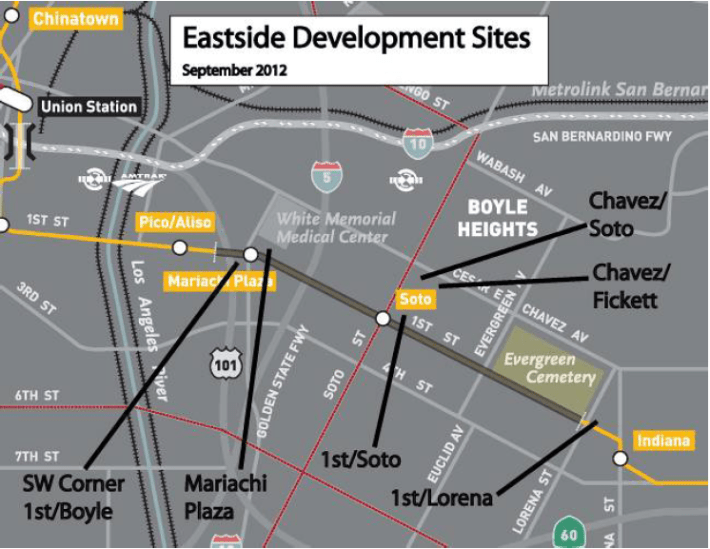City and Residents Debate Fate of Lot at 1st and Boyle
8:29 PM PST on February 3, 2016

"Dots are not a very democratic way to do things."
If there was a message Boyle Heights residents wanted to send to the city regarding their community outreach process last night, that seemed to be it.
They were referring to the colored stickers planners often ask residents to use to signal their planning priorities. In this case, residents were asked to choose between land-use options for the CRA-owned vacant lot at 1st and Boyle that sits across the street from Mariachi Plaza. Did they want to see an open space/plaza-type project, mixed-use development (commercial space on the ground floor, residential or office spaces on the upper floors), or town home-style live-work spaces?
The residents' answers seemed to be, in no particular order, "none of the above," "this is a scam," "don't we need to know who this housing would be for before we vote on it?" "we need more parking," and "why didn't you come to us for suggestions before coming up with these plans?"
Being asked to put dots next to a particular poster board, argued several people, was akin to asking the community to rubber stamp the city's suggestions to make it look like genuine dialogue had taken place. And they weren't going to stand for it.
Planners tried explaining that the proposed projects seen on the poster boards were only suggested land uses, not an effort to designate specific businesses or structures for the site.
Coming in with flexible suggestions for land uses -- to the city -- made perfect sense. For one, even if residents hated the proposals, visuals gave them something to respond to -- a common ground for discussion to begin around land uses.
Second, as Rocio Hernandez, Boyle Heights Area Director for Jose Huizar, told the crowd, the city is aware that the community has no interest in hearing promises that would not be kept. The land-use suggestions planners were offering were ones they felt the CRA would be likely to approve as well as ones that would help the city fetch a fair price for the land. As the city itself does not own the land, it can't just use the land as it sees fit.
Third, the city has a very limited time frame in which to get a project for the site off the ground.
After the CRA was dissolved in 2012, the question then became what to do with its many remaining assets. But it was not until the very end of 2014 that the city was able to enter into option agreements with the CRA on ten of those parcels of land. The option agreements are structured to allow the city to sell the properties to third-party developers at fair-market value without impact to the state's General Fund. The rest of the CRA-owned assets were put up for sale last summer.
Josh Rohmer of the City Administrative Office told meeting attendees that the city was not comfortable with allowing the lot at 1st and Boyle to be sold to the highest bidder. Instead, he said, they were hoping to put together a Request for Proposals (RFP) with a set of preferences and requirements that reflected the values of the community. The catch was that process needed to be well underway by 2017.
If the city could prove that they were moving forward on a project, it was possible, Rohmer said, that they could get an extension of a year to finish the planning process. But it would still mean that planning had to start sooner rather than later.
Aldo Medina, who, on behalf of the East L.A. Community Corporation, has provided technical assistance to the small businesses along the 1st Street corridor for a few years now, asked if it would be possible to open up the lot for parking while the fate of the lot was being decided. If construction was as far off as two years, he said, access to the lot could still be helpful to local businesses in the meanwhile.
His request was met with applause from the crowd.
Parking is a major concern in the area. For reasons that make no sense to anyone, on a street that is jam-packed with restaurants and other businesses people tend to frequent on their lunch hours (tailors, trophy shops, etc.), parking is restricted on Tuesdays and Wednesdays from noon to 3 p.m. for street sweeping. While the city and Metro clearly both assumed that visitors would use the Gold Line to get to the areas around Mariachi Plaza, that hasn't panned out. That station actually sees some of the fewest boardings in the entire rail network. And folks coming to the area's restaurants are often from around the Southland (Downey, Pomona, etc.), and couldn't easily get to the community via transit, even if they wanted to. Or they are coming for a big purchase order of trophies and can't carry them onto the train by themselves.
So, while parking across the street from a transit station might seem like a waste to some, business owners in the community still see it as key to their survival.
"How can we develop ourselves if you keep bringing in more businesses but no parking?" asked Carlos Ortez, owner of Un Solo Sol.
There was no answer with regard to whether the lot could be opened for parking; the planners said they would have to check with the CRA.
Nor was it clear what the next step with regard to the lot would be. A follow-up meeting is planned for February 16 at 7 p.m., but there seemed to be less clarity about what residents might see at the site, not more. As people swarmed the planners standing at the poster boards, they reiterated their interest in seeing affordable housing, a place for children to play, a quiet place for the elderly, a laundromat (to replace the one that had been on that lot previously), retail spaces that accommodated the kinds of very small businesses seen in low-income communities, and, of course, parking.
For me, one of the most striking things about last night's meeting was its complete independence from any discussions that have been (or are about to be) had regarding the future of the lot across the street (Mariachi Plaza), the lot on Cesar Chavez and Fickett (previously slated to be a grocery store), and the affordable housing projects going up all along the corridor, including one on the opposite corner of 1st and Boyle. The reasons for this are likely more logistical than anything. Metro owns all of the aforementioned lots. The city does not own the lot at 1st and Boyle, has a deadline which must be met, and has an entirely different process that must be followed.

Logistics aside, it still seems like a lost opportunity to step back and look at the community as a larger whole. Change happens so quickly in Boyle Heights and usually with very little input from the community. This is one of those rare instances where the city and the residents could stop to take a breath together and look at the bigger picture. Given the community's very warranted concerns about gentrification, there seems no better moment to ask how projects in such close proximity could complement each other so as to foster development and encourage job growth while limiting displacement and safeguarding community well-being.
The next meeting for the lot at 1st and Boyle will be held February 16 at 7 p.m. at Councilmember Jose Huizar's Field Office. Meetings to discuss the fate of Mariachi Plaza and the lot at Cesar Chavez and Fickett have yet to be scheduled, but are expected to take place this spring. If you'd like to be reminded of how the process around Mariachi Plaza and Metro's others has unfolded, be our guest, here.
Sahra is Communities Editor for Streetsblog L.A., covering the intersection of mobility with race, class, history, representation, policing, housing, health, culture, community, and access to the public space in Boyle Heights and South Central Los Angeles.
Stay in touch
Sign up for our free newsletter
More from Streetsblog Los Angeles
Metro Board Funds Free Student Transit Pass Program through July 2025
Metro student free passes funded another year - plus other updates from today's Metro board meeting
Eyes on the Street: New Lincoln Park Avenue Bike Lanes
The recently installed 1.25-mile long bikeway spans Lincoln Park Avenue, Flora Avenue, and Sierra Street - it's arguably the first new bike facility of the Measure HLA era




